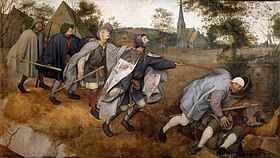|
The blind leading the blind"The blind leading the blind" is an idiom[1] and a metaphor in the form of a parallel phrase. It is used to describe a situation where a person who is ignorant of a given subject is getting advice and help from another person who is just as ignorant of the subject.[2] HistoryThe idiom can be traced back to the Upanishads, which were written around 800 BCE[3]
A similar metaphor exists in the Buddhist Pali Canon, composed in North India, and preserved orally until it was committed to writing during the Fourth Buddhist Council in Sri Lanka in 29 BCE.
The similar expression appears in Horace (Epistles, book I, epistle XVII, line 4): caecus iter monstrare uelit ("the blind wishing to show the way"). Horace was the leading Roman lyric poet during the time of Augustus (27 BCE – 14 CE)[6] The phrase also features in the New Testament. It is mentioned several times in the gospels, with similar stories appearing in Matthew, Luke and the non-canonical gospel of Thomas, possibly reaching the evangelists via the hypothesised Q source.
Sextus Empiricus (160 – 210 CE) compares ignorant teachers and blind guides in his Outlines of Scepticism:
The phrase appears in Adagia, an annotated collection of Greek and Latin proverbs, compiled during the Renaissance by Dutch humanist Desiderius Erasmus Roterodamus. The first edition, titled Collectanea Adagiorum, was published in Paris in 1500 CE.[8] Augustine of Hippo, a Catholic theologian, writes ″Vae caecis ducentibus! Vae caecis sequentibus!″, Latin for "woe to the blind that lead, woe to the blind that follow".[9] Artistic depictions Perhaps the most famous artistic depiction of the phrase is Pieter Bruegel's The Blind Leading the Blind. The distemper on canvas painting was completed in 1568, and is currently in the collection of the Museo di Capodimonte in Naples, Italy. References
External linksLook up blind leading the blind in Wiktionary, the free dictionary.
|